初中英语八大时态表
- 格式:doc
- 大小:37.50 KB
- 文档页数:4

初中英语八大时态表格时态名称结构(以动词do为例)用法示例常见时间状语一般现在时do/doesI often play basketball.(表示经常或习惯性的动作)<br>He likes reading.(表示现在的状态、事实或真理)always, usually, often, sometimes, every day/week/month/year等一般过去时didI went to the park yesterday.(表示过去某个时间发生的动作或存在的状态)yesterday, last week/month/year, just now, a moment ago等一般将来时will/shall do(第一人称常用shall),be going to doI will go to Beijing next week.(表示将来某个时间要发生的动作或存在的状态)<br>He is going to study hard.(表示打算、计划做某事)tomorrow, nextweek/month/year, in + 一段时间等现在进行时am/is/are doingShe is reading a book now.(表示此时此刻正在进行的动作)now, at the moment, look, listen等提示词出现时过去进行时was/were doingI was doing my homework when he came in.(表示过去某个时刻正在进行的动作,常与一般过去时搭配使用)at this time yesterday, from 7 to 9 last night等现在完成时have/has doneI have already finished my homework.(表示过去发生的动作对现在造成的影响或结果)<br>He has lived here for ten years.(表示过去已经开始,持续到现在的动作或状态)already, yet, just, ever, never, for + 时间段, since + 时间点等过去完成时had doneWhen I got to the station, the train had already left.(表示在过去某个时间或动作之前已经发生或完成的动作,即“过去的过去”)by the end of last year, before + 一般过去时的句子等将来进行时will be doingI will be having a meeting at this time tomorrow.(表示将来某个时刻或时间段正在进行的动作)at this time tomorrow等。
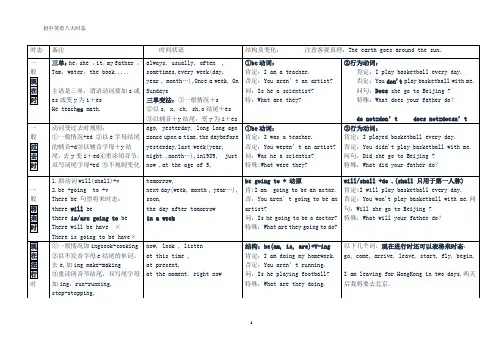
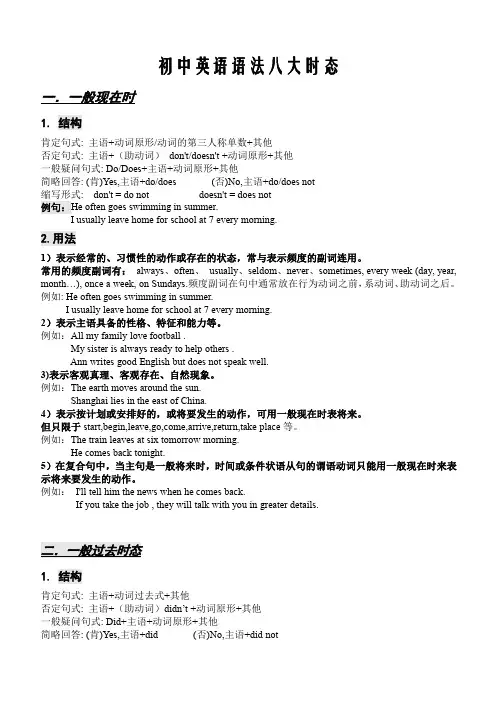
初中英语语法八大时态一.一般现在时1. 结构肯定句式: 主语+动词原形/动词的第三人称单数+其他 否定句式: 主语+(助动词) don't/doesn't +动词原形+其他 一般疑问句式: Do/Does+主语+动词原形+其他 简略回答: (肯)Yes,主语+do/does (否)No,主语+do/does not 缩写形式: don't = do not doesn't = does not 例句:He often goes swimming in summer. I usually leave home for school at 7 every morning.2.用法1)表示经常的、习惯性的动作或存在的状态,常与表示频度的副词连用。
常用的频度副词有: always、often、 usually、seldom、never、sometimes, every week (day, year, month…), once a week, on Sundays.频度副词在句中通常放在行为动词之前, 系动词、 助动词之后。
例如: He often goes swimming in summer. I usually leave home for school at 7 every morning. 2)表示主语具备的性格、特征和能力等。
例如:All my family love football . My sister is always ready to help others . Ann writes good English but does not speak well. 3)表示客观真理、客观存在、自然现象。
例如:The earth moves around the sun. Shanghai lies in the east of China. 4)表示按计划或安排好的,或将要发生的动作,可用一般现在时表将来。
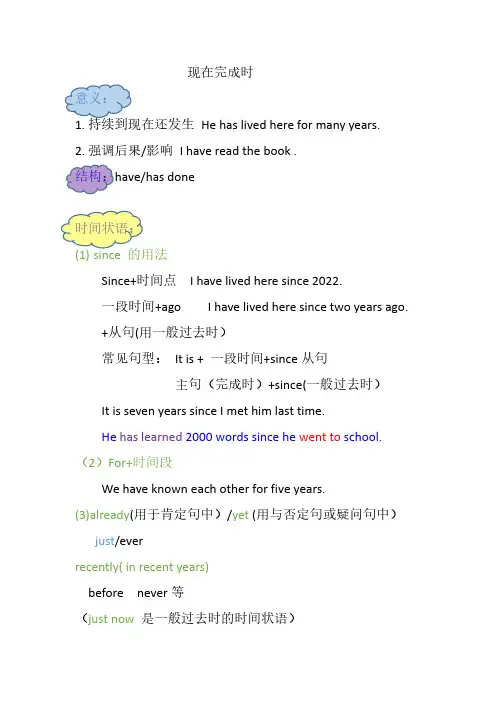
现在完成时意义:He has lived here for many years.2.强调后果/影响I have read the book .结构:时间状语:(1)since 的用法Since+时间点I have lived here since 2022.一段时间+ago I have lived here since two years ago.+从句(用一般过去时)常见句型:It is + 一段时间+since从句主句(完成时)+since(一般过去时)It is seven years since I met him last time.He has learned 2000 words since he went to school.(2)For+时间段We have known each other for five years.(3)already(用于肯定句中)/yet (用与否定句或疑问句中)just/everrecently( in recent years)before never等(just now是一般过去时的时间状语)I have just finished my homework.Have you ever seen one like this?(4So far /in the past few years等,表示:“目前为止”非延续性动词延续性动词非延续性动词延续性动词Borrow Keep Fall asleep Be asleep buy have Catch a cold Have a cold leave Be away Begin/start Be ondie Be dead open Be open Come (to)Be in/at close Be closed区分Have gone to去了没回Have been to去了回来(常与次数once/twice/基数词+times连用)Have been in在某地呆了多久例句:(1)You can’t see her because he has gone to Sibo.(2)He has been to Sibo twice.(3)He has been in this city for two years.备注:Here/there/home 不与介词连用。
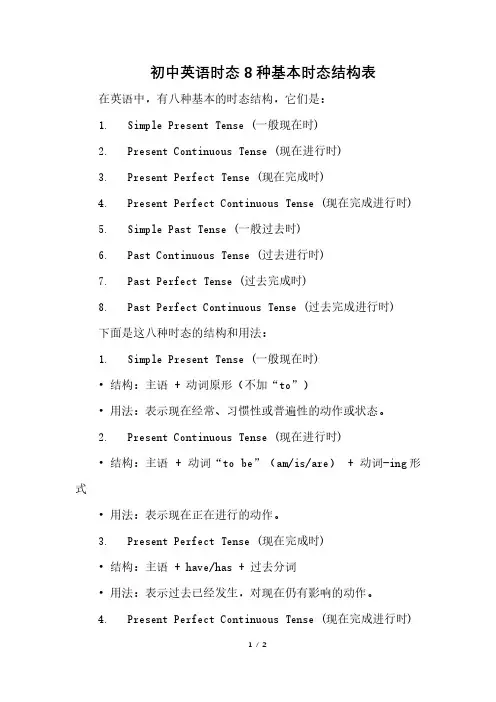
初中英语时态8种基本时态结构表在英语中,有八种基本的时态结构,它们是:1. Simple Present Tense (一般现在时)2. Present Continuous Tense (现在进行时)3. Present Perfect Tense (现在完成时)4. Present Perfect Continuous Tense (现在完成进行时)5. Simple Past Tense (一般过去时)6. Past Continuous Tense (过去进行时)7. Past Perfect Tense (过去完成时)8. Past Perfect Continuous Tense (过去完成进行时)下面是这八种时态的结构和用法:1. Simple Present Tense (一般现在时)•结构:主语 + 动词原形(不加“to”)•用法:表示现在经常、习惯性或普遍性的动作或状态。
2. Present Continuous Tense (现在进行时)•结构:主语 + 动词“to be”(am/is/are) + 动词-ing形式•用法:表示现在正在进行的动作。
3. Present Perfect Tense (现在完成时)•结构:主语 + have/has + 过去分词•用法:表示过去已经发生,对现在仍有影响的动作。
4. Present Perfect Continuous Tense (现在完成进行时)•结构:主语 + have/has been + 动词-ing形式•用法:表示从过去某时开始持续到现在的动作。
5. Simple Past Tense (一般过去时)•结构:主语 + 过去式动词•用法:表示过去某时发生的动作。
6. Past Continuous Tense (过去进行时)•结构:主语 + was/were + 动词-ing形式•用法:表示过去某时正在进行的动作。
7. Past Perfect Tense (过去完成时)•结构:主语 + had + 过去分词•用法:表示过去某时发生的动作在另一过去时间之前已经完成。
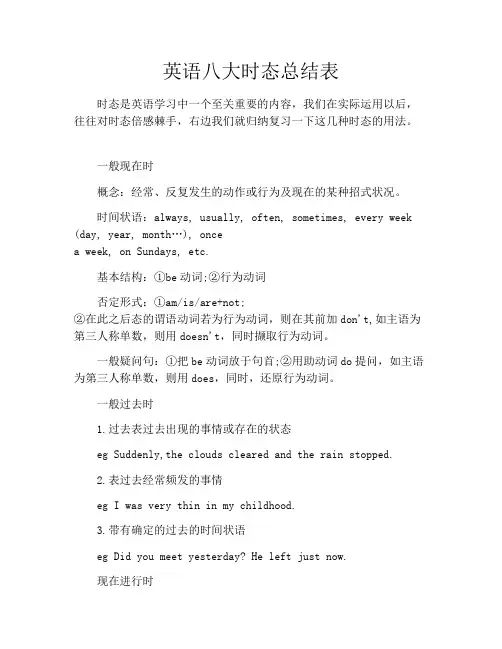
英语八大时态总结表时态是英语学习中一个至关重要的内容,我们在实际运用以后,往往对时态倍感棘手,右边我们就归纳复习一下这几种时态的用法。
一般现在时概念:经常、反复发生的动作或行为及现在的某种招式状况。
时间状语:always, usually, often, sometimes, every week (day, year, month…), oncea week, on Sundays, etc.基本结构:①be动词;②行为动词否定形式:①am/is/are+not;②在此之后态的谓语动词若为行为动词,则在其前加don't,如主语为第三人称单数,则用doesn't,同时撷取行为动词。
一般疑问句:①把be动词放于句首;②用助动词do提问,如主语为第三人称单数,则用does,同时,还原行为动词。
一般过去时1.过去表过去出现的事情或存在的状态eg Suddenly,the clouds cleared and the rain stopped.2.表过去经常频发的事情eg I was very thin in my childhood.3.带有确定的过去的时间状语eg Did you meet yesterday? He left just now.现在进行时1.说话、写文章的当刻正在暴发的动作eg They are having a football match.2.现阶段一直在成功进行的动作eg He is preparing for CET Band Six.3.表示说话人的情感,如赞许、批评等eg She is often doing well at school.4.表示在近期按计划或安排要发生的动作eg Are you staying here till next week?过去进行时1.概念:表示过去某段时间或某一时刻正在发生或进行的行为或动作。
2.时间状语:at this time yesterday, at that time或以when 引导状语的谓语宾语是一般过去时的时间状语等。
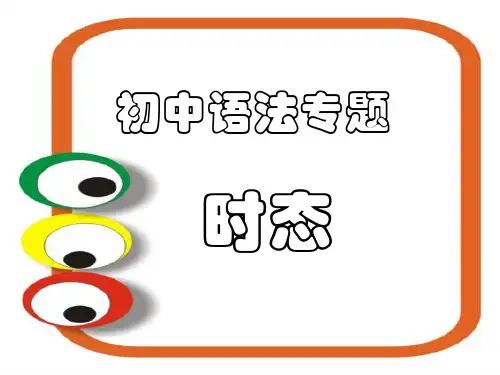
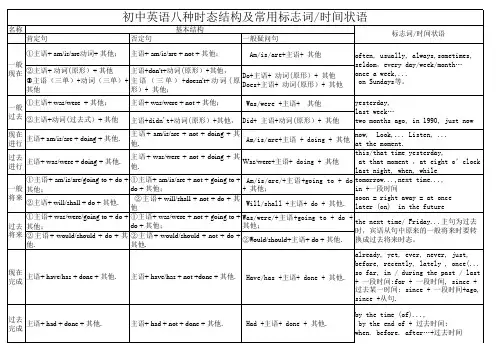
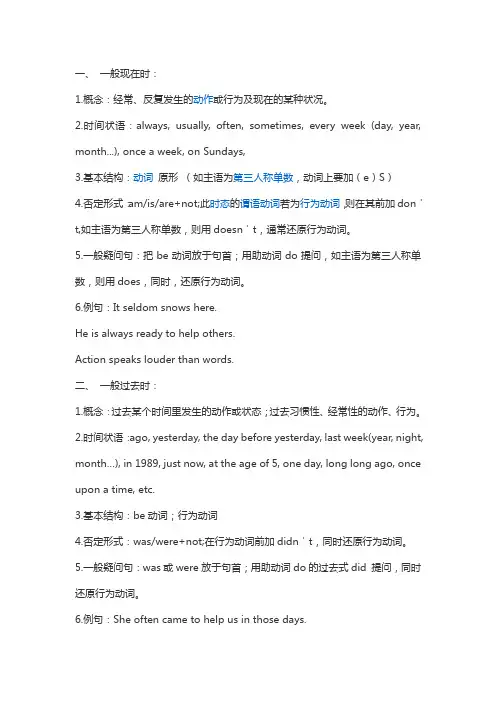
一、一般现在时:1.概念:经常、反复发生的动作或行为及现在的某种状况。
2.时间状语:always, usually, often, sometimes, every week (day, year, month...), once a week, on Sundays,3.基本结构:动词原形(如主语为第三人称单数,动词上要加(e)S)4.否定形式:am/is/are+not;此时态的谓语动词若为行为动词,则在其前加don't,如主语为第三人称单数,则用doesn't,通常还原行为动词。
5.一般疑问句:把be动词放于句首;用助动词do提问,如主语为第三人称单数,则用does,同时,还原行为动词。
6.例句:It seldom snows here.He is always ready to help others.Action speaks louder than words.二、一般过去时:1.概念:过去某个时间里发生的动作或状态;过去习惯性、经常性的动作、行为。
2.时间状语:ago, yesterday, the day before yesterday, last week(year, night, month…), in 1989, just now, at the age of 5, one day, long long ago, once upon a time, etc.3.基本结构:be动词;行为动词4.否定形式:was/were+not;在行为动词前加didn't,同时还原行为动词。
5.一般疑问句:was或were放于句首;用助动词do的过去式did 提问,同时还原行为动词。
6.例句:She often came to help us in those days.I didn't know you were so busy.三、现在进行时:1.概念:表示现阶段或说话时正在进行的动作及行为。
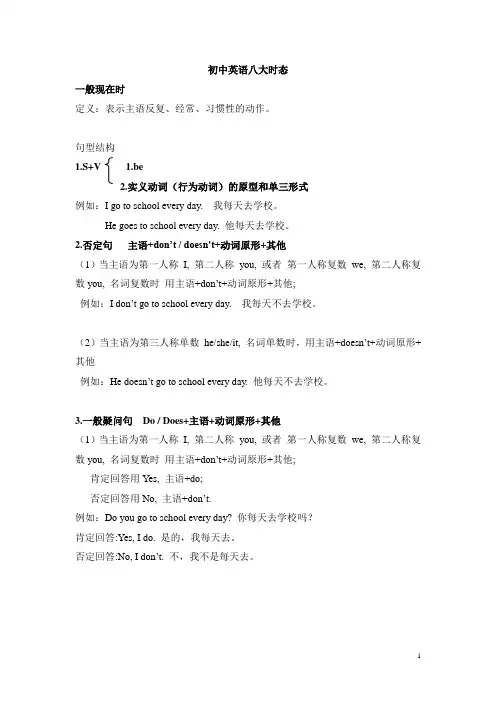
初中英语八大时态一般现在时定义:表示主语反复、经常、习惯性的动作。
句型结构1.S+V 1.be2.实义动词(行为动词)的原型和单三形式例如:I go to school every day. 我每天去学校。
He goes to school every day. 他每天去学校。
2.否定句主语+don’t / doesn't+动词原形+其他(1)当主语为第一人称I, 第二人称you, 或者第一人称复数we, 第二人称复数you, 名词复数时用主语+don’t+动词原形+其他;例如:I don’t go to school every day. 我每天不去学校。
(2)当主语为第三人称单数he/she/it, 名词单数时,用主语+doesn’t+动词原形+其他例如:He doesn’t go to school every day. 他每天不去学校。
3.一般疑问句Do / Does+主语+动词原形+其他(1)当主语为第一人称I, 第二人称you, 或者第一人称复数we, 第二人称复数you, 名词复数时用主语+don’t+动词原形+其他;肯定回答用Yes, 主语+do;否定回答用No, 主语+don’t.例如:Do you go to school every day? 你每天去学校吗?肯定回答:Yes, I do. 是的,我每天去。
否定回答:No, I don’t. 不,我不是每天去。
(2)(2)当主语为第三人称单数he/she/it, 名词单数时,用主语+doesn’t+动词原形+其他肯定回答用Yes, 主语+does;否定回答用No, 主语+doesn’t.例如:Does he go to school every day. 他每天去学校吗?肯定回答:Yes, he does. 是的,他每天去。
否定回答:No, he doesn’t. 不,他不是每天去。
用法1.表示主语的特征或状态。
2.表示客观真理和客观事实。
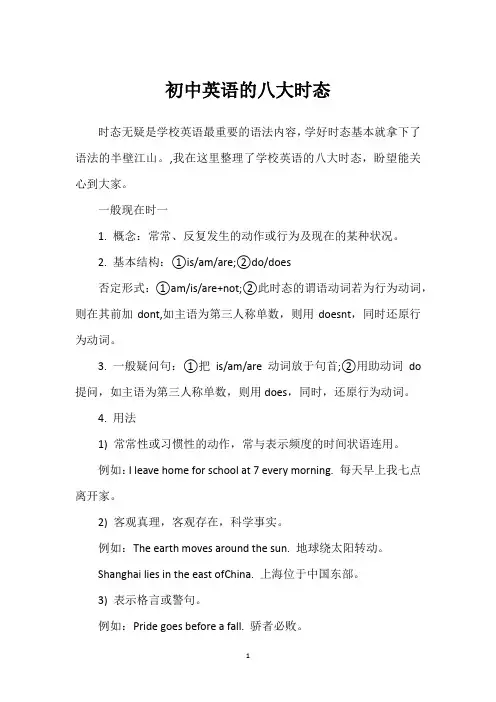
初中英语的八大时态时态无疑是学校英语最重要的语法内容,学好时态基本就拿下了语法的半壁江山。
,我在这里整理了学校英语的八大时态,盼望能关心到大家。
一般现在时一1. 概念:常常、反复发生的动作或行为及现在的某种状况。
2. 基本结构:①is/am/are;②do/does否定形式:①am/is/are+not;②此时态的谓语动词若为行为动词,则在其前加dont,如主语为第三人称单数,则用doesnt,同时还原行为动词。
3. 一般疑问句:①把is/am/are动词放于句首;②用助动词do 提问,如主语为第三人称单数,则用does,同时,还原行为动词。
4. 用法1) 常常性或习惯性的动作,常与表示频度的时间状语连用。
例如:I leave home for school at 7 every morning. 每天早上我七点离开家。
2) 客观真理,客观存在,科学事实。
例如:The earth moves around the sun. 地球绕太阳转动。
Shanghai lies in the east ofChina. 上海位于中国东部。
3) 表示格言或警句。
例如:Pride goes before a fall. 骄者必败。
留意:此用法假如消失在宾语从句中,即使主句是过去时,从句谓语也要用一般现在时。
例如:Columbus proved that the earth is round. 哥伦布证明了地球是圆的。
4) 现在时刻的状态、力量、性格、共性。
例如:I dont want so much. 我不要那么多。
Ann writes good English but does not speak well.安英语写得不错,讲的可不行。
5) 一般现在时表示将来含义a. 下列动词come, go, arrive, leave, start, begin, return的一般现在时可以表示将来,主要用来表示在时间上已确定或支配好的事情。
初中英语八大时态1、一般现在时1.表经常发生的事情、存在的动作或状态eg She sings with the band Crazy Boy.2.表内心活动感情等eg I don't think you are right.3.描述客观真理eg Birds fly in the sky.4.表预定的行为eg The train leaves at 9.一般现在时除主语是第三人称单数时谓语动词要加s外,一律用动词原形。
例句:Summer follows spring. 春天之后是夏天。
The sun rises in the east. 太阳从东方升起。
2、一般过去时1.表过去发生的事情或存在的状态eg Suddenly,the clouds cleared and the rain stopped.2.表过去经常发生的事情eg I was very thin in my childhood.3.带有确定的过去的时间状语eg Did you meet yesterday? He left just now.主要是用来描述在过去某个时候发生的动作或存在的状态。
它也可以用来表示在过去某段时间里经常发生的习惯性动作。
这一点在表达意义上与一般现在时相同,只是所在的时间区域不同而已。
由于它的主要作用如此,所以在使用一般过去时的句子里常常有一个意义较具体的过去时间状语。
这也是它与现在完成时的最大区别之一。
一般过去时由谓语动词的过去式表示,也就是说动词词末要加-ed(除不规则动词外)。
常和一般过去时连用的过去时间状语有:last night (week ,month , year , century , etc.) , yesterday , the day before yesterday , yesterday morning ( afternoon , evening ) , in 1999 , two hours ago ( one week ago , tree years ago , …)等等。
八种时态一、一样此刻时:概念:表示现时期常常或适应发生的动作或存在的状态,或说明主语的特点。
用法:A) 表示此刻发生的动作、情形、状态和特点。
B) 常常性、适应性动作。
常与频率副词连用。
Eg.:He always helps others. (他老是帮忙他人。
)C) 客观事实和普遍真理。
Eg. The earth turns round the sun.(地球绕着太阳转)Light travels faster than sound.(光传播比声音快)D) 表示一个按规定、打算或安排要发生的动作,(仅限于某些表示“来、去、动、停、开始、终止、继续”等的动词)能够与表示以后时刻的状语搭配利用。
常见的用法是:飞机、火车、轮船、汽车等按期定点运行的交通方式。
Eg.The next train leaves at 3 o'clock this afternoon.Eg.How often does this shuttle bus run? (这班车多久一趟?)E) 在时刻状语从句中(以when, after, before, while, until, as soonas等引导)和条件状语从句中(以if,unless引导),用一样此刻时期替一样以后时,句子能够有以后时刻。
Eg.:Please ring me up as soon as you arrive in Germany.(你一到德国就给我打电话)If it rains tomorrow,we will have to stay at home.(若是明天下雨咱们就只好呆在家)时刻状语:always, usually, often, sometimes, every week (day, year, month…), once a week, on Sundays, etc.大体结构:①be动词;②行为动词否定形式:①am/is/are+not;②现在态的谓语动词假设为行为动词,那么在其前加don't,如主语为第三人称单数,那么用doesn't,同时还原行为动词。
初中英语基本时态总结Ⅰ、一般现在时1、概念:1)表示经常性或习惯性的动作,常与表示频度的时间状语连用。
时间状语:always, usually, often, sometimes, seldom, never, every day, twice a week, on Sunday, etc.(提问用How often)例:I leave home for school at 7 every morning.Tom gets up at 6:00 every morning.2)客观真理,客观存在,科学事实。
例:The earth moves around the sun. 地球绕太阳转动。
Shanghai lies in the east of China. 上海位于中国东部。
3)格言或警句。
例:Pride goes before a fall. 骄者必败。
注意:宾语从句中,即使主句是过去时,从句谓语是客观真理也要用一般现在时。
例:Columbus proved that the earth is round. 哥伦布证实了地球是圆的。
2、结构:表状态S+ am/is/are+ P (句中有实义动词不用be)表动作S+V原+O (若主语是单三人称,谓动加s/es。
)3、句式变化:变疑问,有be把be提到主语前;无be在主语前加do/does,谓动变为原形。
变否定,有be在be后加“not”;无be在主语后加don’t/doesn’t,谓动变为原形。
例:①They are in the classroom. →Are they in the classroom? Yes, they are./No, they aren’t. →They aren’t in the classroom②He often waters the flowers . → Does he often water the flowers?Yes, he does. / No, he doesn’t. →He doesn’t often water the flowersⅡ、一般过去时1、概念:1)表示在确定的过去时间里所发生的动作或存在的状态。
初中英语必须掌握的8大时态英语八大时态:一. 一般现在时标志:动词原形1. 表示经常性或习惯性动作,常与表频度的时间状语连用:She often speaks English.I leave home for school at 7 every morning.2. 表示现在的状态、特征、职业、能力、感觉等:He seems to feel a bit down today.He works as a driver.3. 表示真理、客观存在、科学事实或用于格言警句中:Shanghai lies in the east of China.Columbus proved that the earth is round.Where there is a will, there is a way.4. 表示现在瞬间的动作:Here comes the bus!5. 表示将来1) 表按规定、计划、安排将要发生的动作(仅限于某些表示“来、去、动、停、开始、结束、继续”等的趋向动词),可以与表示未来的时间状语搭配使用。
常见的用法是:飞机、火车、轮船、汽车等定期定点运行的交通状况。
如:The next train leaves at 3 o’clock this afternoon.How often does the shuttle bus run?2) 在时间和条件状语从句中常使用一般现在时表示将来发生的事情:When Bill comes (不用will come), ask him to wait for me.I shall go there tomorrow unless I’m too bus y.二. 一般过去时标志:动词过去式*闭音节:元音字母a, e, i, o, u如果发字母本来的音则称为开音节,否则称为闭音节。
1. 表示过去某时所发生的动作或存在的状态,常与表示过去的时间状语连用(e.g. yesterday, this morning, just now, a moment ago, in May, last night/year / week, once upon a time, the other day, before …,when …, in the past等)。